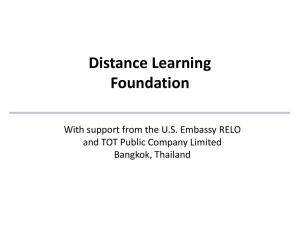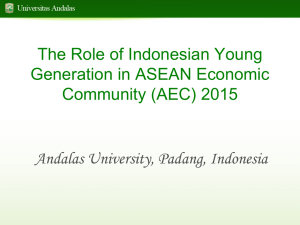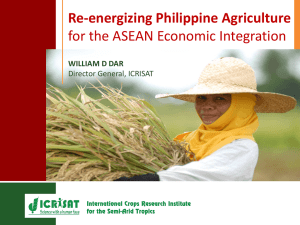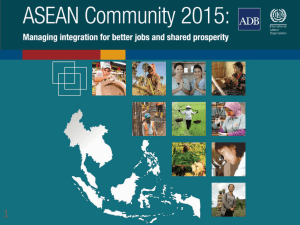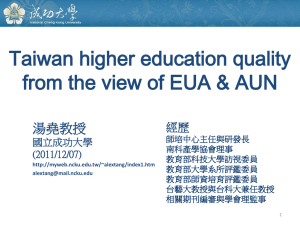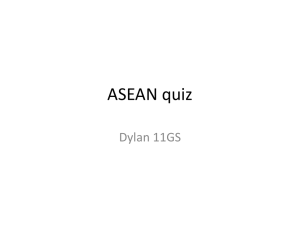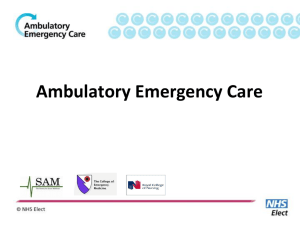Initiatives on Monitoring ASEAN Integration and the ASEAN
advertisement
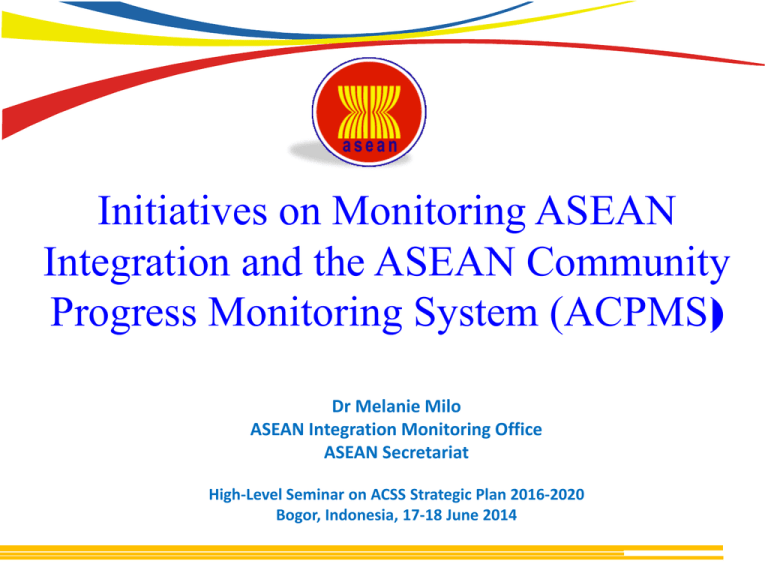
Initiatives on Monitoring ASEAN Integration and the ASEAN Community Progress Monitoring System (ACPMS) Dr Melanie Milo ASEAN Integration Monitoring Office ASEAN Secretariat High-Level Seminar on ACSS Strategic Plan 2016-2020 Bogor, Indonesia, 17-18 June 2014 The Mandate o Blueprints: o ASEC shall monitor and review the implementation of the Blueprints o ASEC shall develop and adopt indicators and systems to monitor and assess the progress of implementation o Mid-term review to be undertaken when necessary ASEC Monitoring Tools Goal / Impact Intermediate Outcome Immediate Outcome ASCC Result/ General OutOutcome come Sectoral based level Monito outcomes ring system ASCC Scorecard AEC Cross Sector AEC High-Impact indicators A C P M S ASR AFIR AISR AIMR AIS Output Activity Input ATSR Compliance/ Implementation Monitoring system AEC Scorecard ASCC Blueprint Implementati on Monitoring System MDG Who is monitoring the AEC Blueprint? o AIMO o o o Input, Activity, and Output level: AEC Scorecard Outcome and Impact: AEC High Impact Indicators Outcome: Monitoring and Surveillance Report o ASEANstats o ERIA o o o Studies to Further Improve the AEC Scorecard (2010, 2011, 2012, 2014) Focused on key areas Questionnaires and surveys Key Mandate of AIMO Establishment of ASEAN Integration Monitoring Office (AIMO) in 2010 by the ASEAN Finance Ministers Key mandate: strengthen regional economic surveillance and monitoring of the AEC to support the integration process AIMO also serves as the policy support unit of the AEC Department within ASEC, with support from the Statistical Division (ASEANstats) How does AIMO monitor the AEC? Monitor the compliance of AEC commitments through the AEC Scorecard ASEAN ECONOMIC COMMUNITY How does AIMO monitor the AEC? Development of monitoring reports and technical papers on various initiatives under the AEC Monitoring Reports Frequency/Contents Data/Indicators Used ASEAN Surveillance Report (ASR) Annual; macro and financial developments; progress monitoring of AEC Macro/surveillance data (real, monetary, fiscal, external, corporate sector data); AEC compliance scorecard; trade integration indicators ASEAN Financial Integration Report (AFIR) Annual; assessment of financial sector integration initiatives and measures Financial integration indicators (quantity and price-based); simple gravity/econometric models; AEC compliance scorecard ASEAN Investment Surveillance Report (AISR) Annual; FDI developments and trends (global and regional); FDI policy issues and challenges FDI indicators; AEC compliance scorecard; trade costs and business performance indicators ASEAN Insurance Report (AIS) Annual; insurance market developments and trends; policy issues Insurance market indicators; macro data ASEAN Integration Monitoring Report* (AIMR) Annual; developments and trends on regional trade in goods, services, investment, and facilitation; assessment of policy issues AEC high impact indicators; trade gravity/econometric models ASEAN Trade in Services Report* (ATSR) Annual; assessment of trade in services trends and developments; restrictiveness index; actual services regulations ASEAN services trade database *new reports prepared in collaboration with the World Bank; first AIMR to be completed in October 2012; first ATSR to be completed in 1Q 2013. How does AIMO monitor the AEC? Development of monitoring tools/indicators and databases on regional economic integration (e.g., AEC high-impact indicators) How does ASEANStats monitor the AEC? o ASEAN Community Statistical System (ACSS) o ASEAN Community Progress Monitoring System (ACPMS) and ASEAN Brief o Reports the General Outcomes of ASEAN integration initiatives, both under the AEC and ASCC o ACPMS 2007 and ASEAN Brief 2007 – first issue o ACPMS 2012 and ASEAN Brief 2012 – second issue How does ASEANStats monitor the AEC? o Started with the ASEAN Base Line Report (ABR) in 2005 o Monitor the programme and initiatives under the Vientiane Action Programme (VAP) o Measuring progress at programme level o More than 300 indicators were introduced and base lines were setup o Difficulty in synthesizing the overall integration progress How does ASEANStats monitor the AEC? o ACPMS 2007, first issue o Received support and commitment from the then AHSOM (ACSS) o Published and disseminated to the public at the ASEAN Summit in Singapore, 2009 o Different focus o o o Reports the general outcomes of integration Mostly outcome indicators 46 indicators: 21 AEC indicators and 26 ASCC indicators How does ASEANStats monitor the AEC? o ACPMS 2012, second issue o Published and disseminated to the public through a press release in 4 AMSs and ASEC o Broader framework o o Enhanced the Framework 57 indicators: 29 AEC indicators and 28 ASCC indicators Framework: Monitoring the AEC Single market and production base • Free flow of goods • Free flow of services • Free flow of investment • Freer flow of capital • Free flow of skilled labour Income convergence; Productivity convergence; Intra-ASEAN tourism; Price convergence; IntraASEAN trade in goods; Tariff reduction; Trade facilitation; Intra-ASEAN trade in services; Services trade liberalization; Intra-ASEAN FDI; Corporate tax rate; Convergence in financial returns; Convergence in skilled labour wages. Competitive economic region Global competitiveness index; Technological capacity (science and tech graduates, R&D expenditures, researchers per population, telephone subscribers); Science & technical publications; Innovation (patent and trademark applications); Technological capability (high tech exports) Equitable economic development ASEAN6:CLMV ratios of income per capita, intraASEAN trade, and intra-ASEAN FDI, Cost of business start up. Integration into the global economy Extra-ASEAN trade in goods, extra-ASEAN inward FDI, extra-ASEAN tourism arrivals Framework: Monitoring ASCC Human development Social welfare and protection Social justice and rights Ensuring environmental sustainability • Education • Human resource and entrepreneurship • Poverty • Income distribution • Health HDI, education, literacy, school enrolment. Poverty, income inequality, life expectancy, child mortality, underweight children, government expenditure on health, incidence of diseases . Female employment-to-population ratio, youth employment-to-population ratio Carbon emission, CFC consumption, transboundary haze, extent of protected area and forest cover, access to improved drinking and sanitary facility. (not available) Building ASEAN Identity Narrowing the development gap ASEAN6:CLMV gaps in income distribution, life expectancy, child mortality, literacy, school enrolment, educational attainment. Example of ACPMS Indicators and the Rationale Single Market and Production Base • AEC 5.3: Intra-industry trade – As economies become more integrated the value of intraindustry trade index would increase • AEC 7: Cost to export and import one container of goods (from World Bank’s Doing Business) – One important measure of facilitating the establishment of a single market is through trade facilitation. Trade facilitation should lead to a lower cost of exporting and importing goods Example of ACPMS Indicators and the Rationale Single Market and Production Base • AEC 12: Convergence in interest rates – Real interest rates represent the real price of capital. As the capital markets of AMSs become more integrated, financial capital will flow more freely, and will be reflected in the tendency for the real interest rates to become more equal over time. • AEC 14: Convergence in government bond yields – With more integrated capital markets, there will be a tendency of a co-movement in AMSs government bond yields. Way forward AIMO is working towards developing a unified outcomes-based regional integration monitoring mechanism. – A brainstorming workshop was funded by the EU-ARISE on improving the current regional monitoring integration system last week. • Combination of international experts on regional integration monitoring mechanisms and the desk officers. – Other ongoing TAs – Anchor the preparation of the ASEAN Integration Report; accompanying volume to the ACPMS • Important to effectively communicate the AEC in the lead-up to 2015 • A critical element of the AEC post-2015 agenda in order to inform and guide the process towards deepening regional economic integration in the next 10 years (AEC 2025) Data Requirements • With clear framework and rationale, data needs can be specifically defined: – Choice of indices/targets/indicators – Quantitative measures have to be specified in terms of key features, characteristics and data requirements • Data sources: not limited to primary sources (data that are already available in ASEAN Secretariat and collected from NSOs); include secondary sources (from multilateral organisations such as the World Bank, IMF, UNCTAD, OECD) THANK YOU
